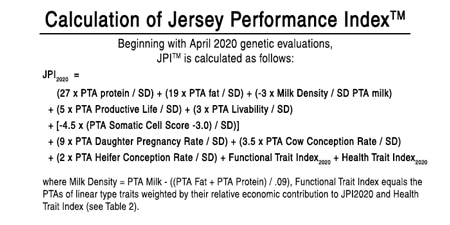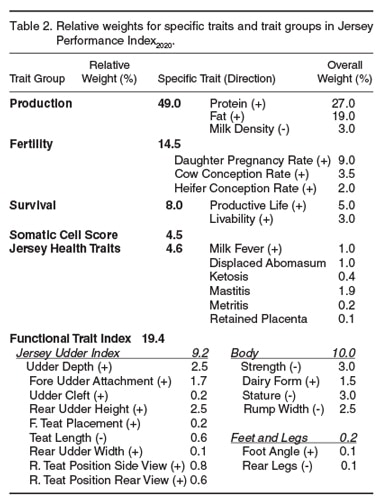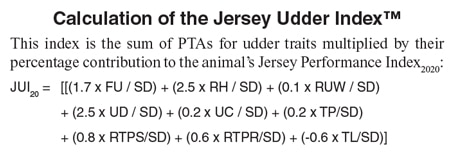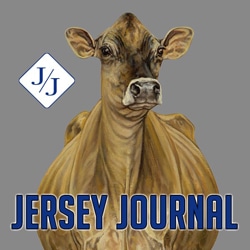Learning More about JPI 2020
Updates to Jersey Performance IndexTM authorized by the AJCA Board of Directors were implemented with the April 2020 official CDCB-AJCA genetic evaluations. JPI2020 predicts the efficiency of production by expressing lifetime production of fat and protein per unit of feed consumed. New traits included in JPI2020 are the six Jersey Health Traits (learn more) and two linear type traits—Rear Teat Placement Side View and Rear Teat Placement Rear View (read more).
Follow this link to see a 2017 and 2020 comparison of JPI.
As with JPI2017 , JPI2020 applies the key principles of Jersey sustainability identified by researchers Jude Capper and Roger Cady (J. L. Capper & R. M. Cady (2012). J. Dairy Sci. 95: 165-176). The three primary drivers of U.S. dairy cow sustainability are production, milk nutrient density, and body size. Specifically, Jerseys need to increase milk yield, maintain—or better improve—component levels, and maintain an optimum body size. The focus on Jersey sustainability was retained for JPI2020.
Traits and their percentage of JPI2020 are 27% PTA protein; 19% PTA fat; 3% Milk Density; 19.4% Functional Trait Index (subsets are Jersey Udder IndexTM, Feet and Legs and Body); 14.5% Fertility (includes 9% Daughter Pregnancy Rate, 3.5% Cow Conception Rate and 2% Heifer Conception Rate); 8% Survival (includes 5% Productive Life and 3% Livability); 4.5% Somatic Cell Score; and six new Jersey Health Traits at 4.6% (Milk Fever 1.0%; Displaced Abomasum 1.0%; Ketosis 0.4%; Mastitis 1.9%; Metritis 0.2% and Retained Placenta 0.1.%). (Fig. 1)
Milk Density is calculated by subtracting the sum of PTA Protein and PTA Fat divided by .09 from PTA Milk. Overall, 49% of the emphasis in JPI2020 is on production, 27% on fitness, 19.4% on functional type and 4.6% on disease resistance.

The goal behind the update to JPI formula was logical. It allows Jersey breed progress to continue, while ensuring tomorrow’s Jersey cattle are genetically predisposed to remain healthy, fertile and function while producing high levels of milk solids. Dr. Kent Weigel, University of Wisconsin-Madison, led the research and development of JPI2020. The updated formula is derived from a prediction of efficiency for more than 300,000 Jersey females born since 2010 who have lactation and type information.
Lifetime production was tallied for each female. Individual type traits were used to predict body weight, which was then used to determine their lifetime feed intake. The ratio of lifetime production to lifetime feed intake was predicted using a model that included individual genetic evaluations for production traits, linear type traits, somatic cell score, productive life, livability and fertility measures. Contribution of the six health traits was determined by the amount of variation they explained in productive life and livability.
JPI is based on the ratio of lifetime combined fat and protein to lifetime dry matter intake, relative to other cows in the same herd born in the same year. Feed during the rearing period is considered, as are differences in maintenance intake for cows of different predicted body size. For cows that are still alive, we take how much they have produced and eaten to date.

Milk Density
Milk Density (3% of the index), formerly named CFP Milk, is a breed-specific adjustment to PTA Milk based on the target that every pound of PTA milk must include 0.09 pounds of combined fat and protein. Milk Density is based on the idea it is preferable to have total yield of pounds fat and pounds protein come from more concentrated milk instead of a greater volume of watery milk.
For example, two bulls each have 75 pounds of combined fat and protein, but a large difference in their PTA Milk of 250 compared to 1,250 pounds. Relative to the target of 0.09 pounds of combined fat and protein in one-pound PTA milk, the bull with a PTA Milk of 250 exceeds that concentration and will gain approximately three IndexTM points. The other bull, at PTA Milk of 1,250 pounds, transmits more water relative to components. Therefore, he will lose approximately two IndexTM points.
The Milk Density attribution will result in a difference of five IndexTM points between the two example bulls.
Type Within Production
Of the components of IndexTM, only one—the AJCA Functional Trait Index (FTI)—captures the effects of type traits within production on lifetime efficiency. It assesses how functional type traits are important to the Jersey cow’s economic survival. As such, it pinpoints where improvement is needed and needed most, and where opportunities for further gains are possible.

Table 2 shows going forward, what will make the most difference in improving Jersey profitability is increasing selection pressure on udder and body traits. Some traits are more important than others. Among traits in the Jersey Udder IndexTM (JUI), which is derived from FTI, Udder Depth is the most important, followed by Fore Udder Attachment and Rear Udder Height. JUI is reported as JPITM points; in other words, how many points udder traits add (or subtract) from Jersey Performance IndexTM.
Health Traits
The April 2020 genetic evaluations mark the release of six health traits that will help alleviate costly health conditions impacting Jerseys. These traits will help build resistance against displaced abomasum, milk fever, ketosis, mastitis, metritis and retained placenta.
PTAs for each of the health traits will be the predicted daughter difference for resistance above or below the Jersey breed average. The larger the positive values, the more favorable the genetic resistance to the disorder. These genetic evaluations can help identify individuals that transmit costly difference and help manage their use in breeding programs.
The traits and their weights in JPI2020 are:
• Milk Fever or Hypocalcemia: (1.0%) Typically results after calving due to low total blood calcium levels.
• Displaced abomasum: (1.0%) Enlargement of the abomasum with fluid and/or gas that caused its movement to the left or right of the abdominal cavity; the twisting blocks the digestive process and usually requires veterinary intervention.
• Ketosis: (0.4%) Build-up of ketone bodies that typically occurs due to negative energy balance in early lactation.
• Mastitis: (1.9%) Infectious disease that causes inflammation of the mammary gland; one of the most common and costly diseases of dairy cattle.
• Metritis: (0.2%) Infection of the endometrium (lining of the uterus) after calving.
• Retained placenta: (0.1%) Retention of fetal membranes more than 24 hours after calving.
Combined as the Health Trait Index (HTI), it is reported as JPITM points like JUITM and represents 4.6% of JPI2020.
Major Categories
The objective of Jersey Performance IndexTM is to increase lifetime efficiency. Regrouping traits by functional categories reveals a set of six factors that determine whether cows put money into your pocket, and how much. Production receives 49% of the emphasis in the new formula. There is 13.7 % on udder health by combining direct selection for lower Somatic Cell Score (especially important to capture quality premiums) and JUITM. Fertility at 14.5% includes Daughter Pregnancy Rate, Cow Conception Rate and Heifer Conception Rate. Survival is weighted at 8.2% through PTAs for Productive Life and Livability plus the mobility traits (foot angle, rear legs) in FTI. Lastly, the Jersey-specific Body Weight Composite, at 10%, selects for optimum body size, which is directly related to feed intake directed to body maintenance versus production. Lastly, the Health Trait Index at 4.6% selects for disease resistance.

Summary
Jersey Performance IndexTM (JPITM) is a breed-specific selection tool that has been continually reviewed and updated based on sound science and relative to current economic conditions. “Jersey Performance Index2020 focuses on the Lifetime Efficiency of the Jersey cow in a way no prior versions have done,” said Neal Smith, Executive Secretary and CEO of the American Jersey Cattle Association.
“The updated formula combines leading-edge methods which result in a healthier cow who can produce higher concentrations of components in her milk. While accomplishing all this, JPI2020 helps achieve optimum body size for greater feed and overall efficiency and sustainability, while improving on the Jersey cow’s long appreciated fertility.”




